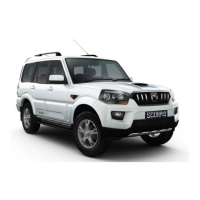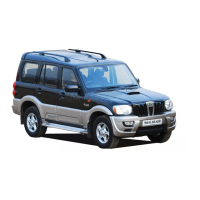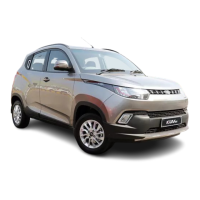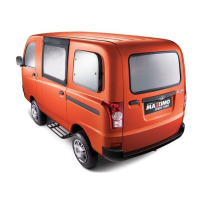11-6
© Copyright Mahindra & Mahindra Ltd. 082014
• When you start driving, verify proper operation of the brakes and steering system
• If, while driving, you hear any strange noise or feel unusual vibration, or if you have
any concerns whatsoever, or if any warning lamps illuminate or buzzers sound,
park/stop the vehicle in a safe location as soon as possible. Identify the cause
and take any necessary remedial action. Contact your Authorized Mahindra
Dealer if necessary
• Never overload or improperly load your vehicle
• Always be attentive while driving and follow safe driving practices
• Always maintain the recommended inflation pressure in tires
• Always drive at a safe speed appropriate for given driving conditions. You must
follow the speed limits
• While backing up, keep a constant lookout for people, particularly children, or
other obstructions or hazardous material that might be present behind the
vehicle
• Avoid loading any items on the roof that will raise the vehicles center of gravity
and make your vehicle more unstable
• Loaded vehicles, with a higher center of gravity, may handle differently than
unloaded vehicles. Extra precautions, such as slower speeds and increased
stopping distance, should be taken when driving a heavily loaded vehicle
• Always slow down in gusty crosswinds. Because of its profile and higher center of
gravity, your vehicle is more sensitive to side winds than an ordinary passenger
car. Slowing down will allow you to have much better control
• When driving off-road or on rugged terrain, do not drive at excessive speeds,
jump, make sharp turns, strike objects, etc. This may cause loss of control or
vehicle rollover causing serious injury. You are also risking expensive damage to
your vehicle's suspension and chassis
• Maintain steering wheel control at all times, especially on rough terrains. Sudden
changes in terrain can result in abrupt steering wheel motion. Make sure you grip
the steering wheel from the outside. Do not grip the spokes
• If the vehicle goes from one type of surface to another (e. g. from concrete to
gravel/sand/mud/snow) there will be a change in the way the vehicle responds,
especially the way it responds to steering, braking and accelerating inputs
• Be extremely careful when driving on pavements made slippery by loose sand,
water, gravel, snow or ice
• If your vehicle goes off the edge of the pavement, slow down, but avoid severe
brake or steering application. Ease the vehicle back onto the pavement only after
reducing your speed. Do not turn the steering wheel too sharply while returning to
the road surface
• It may be safer to stay on the apron or shoulder of the road and slow down
gradually before returning to the pavement. You may lose control if you do not
slow down or if you turn the steering wheel too sharply or abruptly
• In an unavoidable emergency situation where a sudden sharp turn must be made,
turn the steering wheel only as rapidly and as far as required to avoid the
emergency. Excessive steering will result in less vehicle control. Additionally,
smooth variations of the accelerator and/or brake pedal pressure should be
utilized if changes in vehicle speed are called for. Avoid abrupt steering,
acceleration or braking which could result in an increased risk of loss of vehicle
control, vehicle rollover and/or personal injury. Use all available road surfaces to
return the vehicle to a safe direction of travel
11.7.2 Off-Road Driving Precautions
• When driving off-road or on rugged terrains, never over speed or make sharp
turns. This may cause loss of control or vehicle rollover causing serious injury
• Maintain steering wheel control at all times. Sudden changes in terrain can result
in abrupt steering wheel motion
• Do not drive horizontally or diagonally across steep slopes, your vehicle can tip
over sideways. Driving straight up or straight down is preferred
• Drive cautiously to avoid vehicle damage from concealed objects such as rocks
and stumps. You should either know the terrain or map your route before driving
in the area
STARTING AND DRIVING THE VEHICLE

